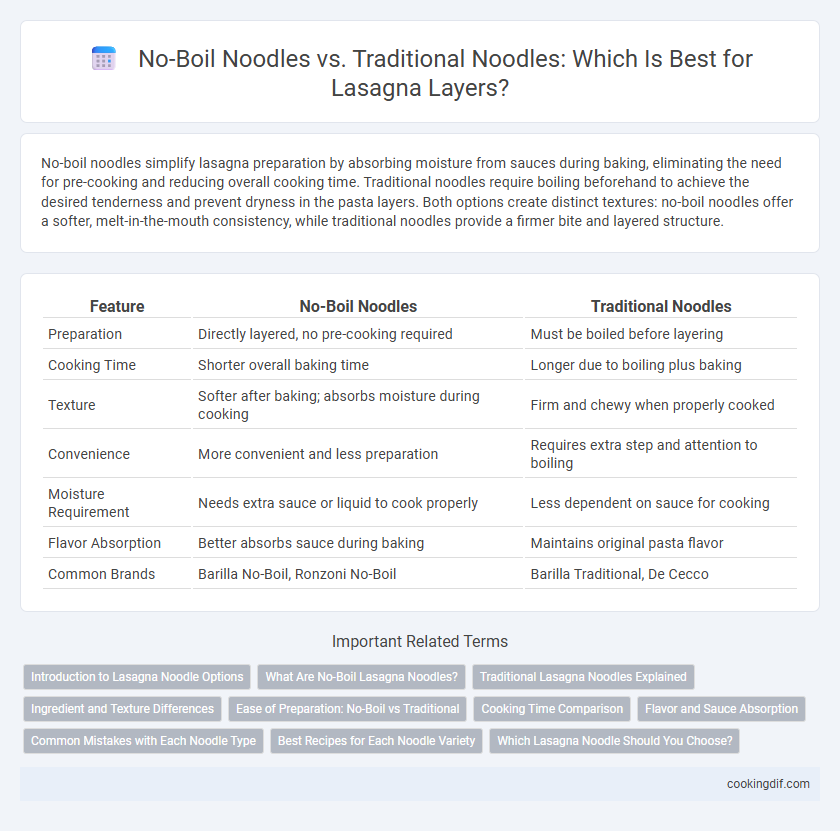No-boil noodles simplify lasagna preparation by absorbing moisture from sauces during baking, eliminating the need for pre-cooking and reducing overall cooking time. Traditional noodles require boiling beforehand to achieve the desired tenderness and prevent dryness in the pasta layers. Both options create distinct textures: no-boil noodles offer a softer, melt-in-the-mouth consistency, while traditional noodles provide a firmer bite and layered structure.
Table of Comparison
| Feature | No-Boil Noodles | Traditional Noodles |
|---|---|---|
| Preparation | Directly layered, no pre-cooking required | Must be boiled before layering |
| Cooking Time | Shorter overall baking time | Longer due to boiling plus baking |
| Texture | Softer after baking; absorbs moisture during cooking | Firm and chewy when properly cooked |
| Convenience | More convenient and less preparation | Requires extra step and attention to boiling |
| Moisture Requirement | Needs extra sauce or liquid to cook properly | Less dependent on sauce for cooking |
| Flavor Absorption | Better absorbs sauce during baking | Maintains original pasta flavor |
| Common Brands | Barilla No-Boil, Ronzoni No-Boil | Barilla Traditional, De Cecco |
Introduction to Lasagna Noodle Options
No-boil lasagna noodles simplify preparation by absorbing sauce and cooking directly in the oven, saving time and reducing the chance of overcooking. Traditional noodles require pre-cooking, offering a firmer texture and more control over doneness, which some chefs prefer for layered pasta dishes. Choosing between no-boil and traditional noodles depends on desired convenience, texture, and cooking method preferences for optimal lasagna results.
What Are No-Boil Lasagna Noodles?
No-boil lasagna noodles are pre-cooked and dried sheets designed to absorb moisture directly from the sauce during baking, eliminating the need for pre-boiling. Traditional noodles require boiling before layering to soften, which adds an extra step and cooking time. No-boil noodles save preparation time and help create evenly cooked, tender pasta layers by absorbing flavors and moisture throughout the baking process.
Traditional Lasagna Noodles Explained
Traditional lasagna noodles require boiling before layering to achieve the perfect texture and ensure even cooking throughout the dish. These noodles absorb sauces slowly, contributing to a balanced moisture level and preventing a soggy lasagna. Their firm structure creates distinct, sturdy layers that hold up well during baking and serving.
Ingredient and Texture Differences
No-boil noodles contain more starch and are thinner than traditional noodles, allowing them to absorb sauce directly during baking, resulting in a softer, more cohesive texture. Traditional noodles require pre-cooking, maintaining a firmer bite and distinct layer separation throughout the lasagna. The ingredient formulation of no-boil noodles includes drying methods that enhance moisture retention, while traditional pasta relies on durum wheat semolina for structural integrity.
Ease of Preparation: No-Boil vs Traditional
No-boil noodles simplify lasagna preparation by eliminating the need for pre-cooking, allowing direct layering from the package to the dish. Traditional noodles require boiling to achieve the right texture, adding extra time and the risk of overcooking or sticking. Choosing no-boil noodles significantly reduces prep time and cleanup, making it an efficient option for home cooks.
Cooking Time Comparison
No-boil noodles significantly reduce lasagna cooking time by eliminating the need for pre-cooking, allowing them to soften and cook fully within the oven's baking process. Traditional noodles require boiling for 8-10 minutes before layering, which extends the overall preparation and cooking duration. Using no-boil noodles streamlines assembly and decreases total lasagna cook time by approximately 15-20 minutes, optimizing kitchen efficiency.
Flavor and Sauce Absorption
No-boil noodles offer a unique advantage in flavor and sauce absorption by allowing pasta layers to soak up more moisture during baking, resulting in a richer, more integrated taste. Traditional noodles, pre-cooked before layering, can sometimes create a firmer texture but may limit sauce penetration, leading to distinct, separate layers. Choosing no-boil noodles enhances the lasagna's overall depth of flavor by fully infusing each layer with the sauce's richness.
Common Mistakes with Each Noodle Type
No-boil noodles often lead to mushy lasagna layers if not sufficiently hydrated during baking, resulting in uneven texture compared to traditional noodles, which require pre-cooking but risk becoming too soft or sticky if overboiled. Using no-boil noodles without adequate sauce coverage prevents proper rehydration, causing dry, undercooked layers, while traditional noodles can clump together or tear if not handled carefully. Balancing moisture and cooking time is critical for both noodle types to achieve perfectly layered, hearty lasagna.
Best Recipes for Each Noodle Variety
No-boil noodles offer convenience and absorb sauce effectively, making them ideal for quick lasagna recipes that emphasize ease without sacrificing flavor. Traditional lasagna noodles provide a firmer texture and allow for layering variations, preferred in classic recipes where precise consistency and mouthfeel are essential. Best recipes for no-boil noodles often include extra sauce to ensure proper hydration, while traditional noodle recipes focus on al dente boiling and layering techniques to achieve perfect structure.
Which Lasagna Noodle Should You Choose?
No-boil noodles offer a convenient, time-saving alternative by absorbing sauce during baking, resulting in a tender texture without pre-cooking, while traditional noodles require boiling prior to layering, allowing for more control over firmness and avoiding potential sogginess. Choose no-boil noodles if you prefer simplicity and a softer pasta layer that melds seamlessly with sauce, especially when using sufficient moisture in your recipe. Opt for traditional noodles when you desire a firmer bite and greater customization of noodle texture in each lasagna layer.
no-boil noodles vs traditional noodles for pasta layers Infographic

 cookingdif.com
cookingdif.com